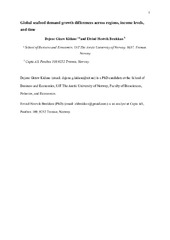Global Seafood Demand Growth Differences across Regions, Income Levels, and Time
Permanent link
https://hdl.handle.net/10037/24554Date
2021-06-01Type
Journal articleTidsskriftartikkel
Peer reviewed
Abstract
We used an index approach to calculate demand growth for seafood in 107 countries from 1984 to 2013. We used the results to calculate aggregate demand growth by income level, regionally, and globally. While seafood production has more than doubled since the mid-1980s, we showed that global demand for seafood has been higher than the global seafood supply. Demand growth for seafood varies across time, countries, regions, and income groups. The average annual seafood demand growth across countries varies between −6% and 7.5%. Global demand growth for seafood has steadily declined since the 1980s; a slowdown of demand in Asia is the main cause. South America and Africa had the highest demand growth from 2004 to 2013, while both North America and Oceania had negative demand growth in this period. High-income countries have had consistently low seafood demand growth from 1984 to 2013, while demand growth in all other income levels has been substantially larger.
Is part of
Kidane, D.G. (2022). Tangled up in prices going up and down: price determination in selected agri-food markets. (Doctoral thesis). https://hdl.handle.net/10037/24850.Publisher
University of Chicago PressCitation
Kidane, Brækkan EH. Global Seafood Demand Growth Differences across Regions, Income Levels, and Time. Marine Resource Economics. 2021;36(3):289-305Metadata
Show full item recordCollections
Copyright 2021 The Author(s)


 English
English norsk
norsk